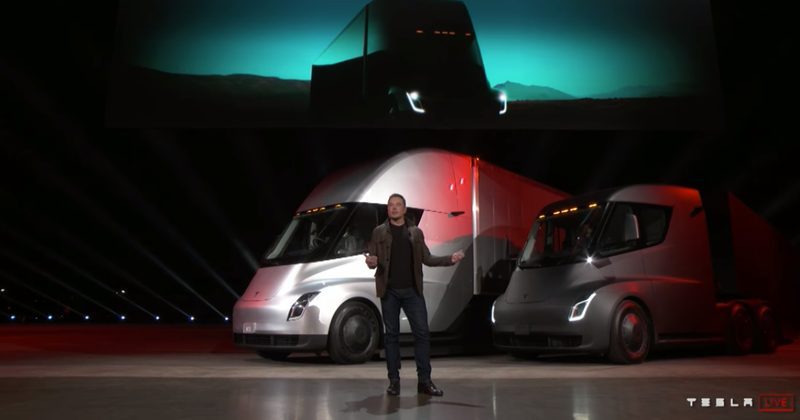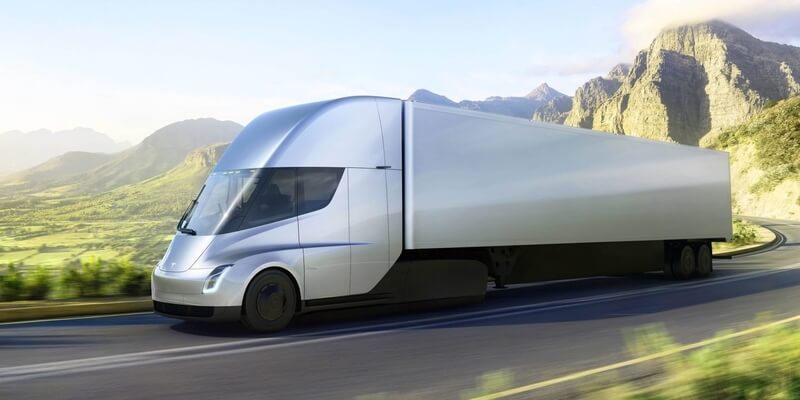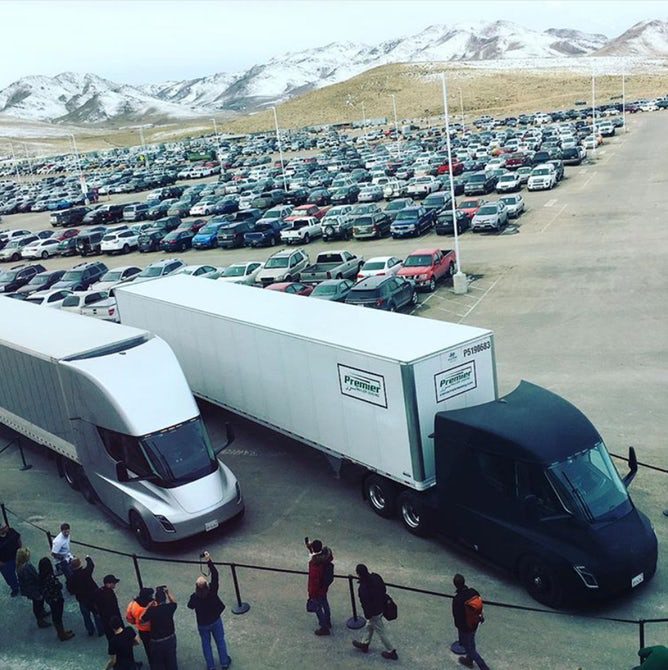
The Future of Logistics with Tesla Semi: Bold Predictions
by TheLorry on 25 August 2025.
It was November when Elon Musk unveiled the Tesla Semi, an electric truck that promised to change the very foundation of logistics. Unlike traditional diesel trucks, this fully electric behemoth can haul 40 tons while reaching speeds of 104 km/h, with a range of 800 km on a single charge. And thanks to its “Mega-chargers”, drivers could recharge for just 30 minutes and cover up to 640 km before needing another stop.
The future of logistics with Tesla Semi isn’t just about building a truck. It’s about rethinking how goods move, how costs are calculated, and how sustainability shapes the industry. Let’s explore the ways this innovation could reshape logistics, both globally and here in Malaysia.

The trucks have even started operation very recently too!
Here’s why we think this Tesla Motors creation will change the future of logistics.
1. Goods transportation is going to be way greener
Based on Frost & Sullivan’s research on the transformation in the trucking industry, one of the four fundamental shifts is Electrification.
Tesla isn’t the first to developed a full electric truck to use for goods transportations. Companies such as Volkswagen, Nikola, Daimler, Cummins and others had jumped ahead way earlier.
But these other trucks do not have the numbers presented by Musk, and none are said to start production in 2019.
As you might have known, big cargo trucks driving along the highway has somewhat of a bad reputation. Besides the mounting cases of accidents and crashes, it is also frowned-upon because of it being not so environmentally friendly.
2. Total operations cost can be lowered significantly
Going back to its performance, Musk has said that can pull 40 tons of backload while still being able to accelerate to 100km/h in 20 seconds.
“If you are pulling a load over the Rockies or some mountains strain up a hill, you are earning 50% more per mile than you are in a diesel truck,” said Musk during the launch event.
Musk also have highlighted how the truck can potentially shift the industry’s paradigm on its total cost of operations by combining leasing, insurance, and maintenance cost as a bundle. This may significantly lower the usual cost of keeping a fleet of trucks in the long run.
3. Trucks to be way safer
And speaking of accidents, the Tesla Semi is said to be equipped with safety features you won’t even believe existed. Mainly to prevent jack-knifing with its independent motors on each wheel.
The freight is also equipped with an auto-pilot system that knows exactly what to do if the truck comes in to close with another vehicle.
Plus, the design accentuates a lower centre of gravity which makes it harder for it to tip an d rollover.
And in terms of the interior design, the driver’s seat is positioned at the very centre, and he/she will have two display touchscreens to view everything there is to know about the truck while driving.
I mean, if this isn’t making truck drivers cool, we don’t know what will.

4. Potential increase in job prospect
Seriously, how cool would it be to drive one of these things? The Tesla Semi may be able attract the younger generations of the workforce to join the ever-present logistics industry, as a cool Tesla truck driver.
5. Full digitisation of freight management
And we mean FULL digitization, not just in terms of live tracking and digital Delivery Order sheets.
It has been found that a single truck being fully utilized while on the road is only around 56% in the US, and about 54% in the EU. The problem exists here in Malaysia too, as trucks with empty backloads travelling long-haul are still ever-present.
Then there’s problem in unavoidable idle times such as sitting at toll gates, traffic, and during loading and unloading.
The Tesla Semi – at least on paper, aims to tackle these under-utilizations and delays by being “digital-native”. It is said to enable usage of empty mile-saving solutions such as an automated freight management and by technological advancements to significantly improve freight utilisation.
You know Tesla is a digitally-driven company, so you can bet there will be digital solutions being sold together with the trucks as well. Though whether any of it would work as well as it claims to remains to be seen.
6. Trucks as an upgradeable solution
The industry as a whole views their freights as more of a one-off product, maintaining it as best as they can to get the most miles out of it before it goes into the scrapyard.
Though with how Tesla puts it, the Semi may become a more complete and “upgradeable” solution to freight operations.
The ecosystem which Tesla brings along with their products would convey that fully electric trucks WILL be a mainstay in the not-so-distant future, and makes it easier to maintain and have them in operation longer, with lesser costs.
7. Bottom line

Two Tesla Semis on their first job, transporting from Nevada to California.
So far, the Tesla Semi looks like a godsend for the logistics industry—or at least, it should be.
Big names like UPS, Pepsi, and Anheuser-Busch have already placed orders. Still, Tesla’s push into heavy trucking is a risky move for Musk and his team. What Musk presented during the launch was bold and disruptive. Yet, many doubt if it can even be mass-produced by 2019. The challenges are huge. From sourcing cobalt for its lithium-ion batteries to building the Mega-charger network, production will not be easy. On top of that, companies must also consider the actual cost of adopting Tesla’s new freight ecosystem. And let’s be honest—the chances of seeing the Tesla Semi on Malaysian highways are slimmer than our morning roti canai. What is for certain now is that Tesla is committing 100% on launching the Tesla Semi, and they are not backing down. If Musk’s other venture, SpaceX is to be a reference, nothing is impossible for them.
At least there’s a bigger chance for the Tesla Roadster to be on Malaysian roads though, and that technological marvel is another article altogether.
As for now, let’s see whether this futuristic truck can live up to its name.
Interested in More?
The future of logistics with Tesla Semi goes far beyond trucks—it represents a shift toward sustainability, cost efficiency, and digital transformation in the transport industry. While Malaysia might not see the Semi on highways immediately, its influence is undeniable. The way goods move, fleets operate, and businesses scale will continue to evolve—and staying ahead means embracing these innovations early.
If you’re ready to future-proof your logistics operations, TheLorry has you covered with tailored solutions:
👉 Need help with your logistics today? Chat with us on WhatsApp, and our team will guide you to the best solution for your needs.
Related Reads from TheLorry Blog
Want to dive deeper into practical logistics insights? Here are some helpful reads to guide your next move:
-
Lorry Transport from Malaysia to Singapore: Cross-Border Movers – Understand the essentials of cross-border logistics and how to move goods or personal items seamlessly between Malaysia and Singapore.
-
TheLorry Price in Malaysia – Get a clear breakdown of moving costs in Malaysia and learn how to choose the right service without overspending.
-
10 Furniture Moving Tips You Should Know – From packing to protecting your furniture, these tips will help ensure a smooth and damage-free move.
👉 Explore more insights and moving guides at TheLorry Blog.
Frequently Asked Questions (FAQ)
What is the Tesla Semi?
How does the Tesla Semi work?
Is the Tesla Semi worth it for logistics companies?
Who can use the Tesla Semi?
Where to book the Tesla Semi?
How much does the Tesla Semi cost?





 MY – EN
MY – EN Singapore
Singapore Indonesia
Indonesia